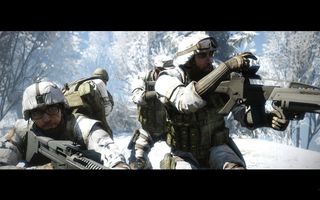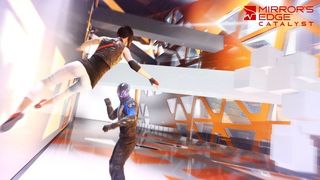Considerate pacing is one of the most basic principles of good campaign design - basic enough, even, that a braying ignoramus like me can summarise the ins and outs without once (OK, twice) reaching for Wikipedia. Is the player a buzzing, bloody mess of adrenaline, thumping his chest astride a pile of dismembered goblins? Throw the poor devil a match-3 minigame so he has a chance to calm down. Conversely, is the player teetering on the brink of catalepsy thanks to a surplus of walk-and-talk storytelling sequences? Quick, parachute in a Capra Demon.
The neat thing about this principle is that you can also apply it to game development. And, well, most forms of conscious human activity. Look at Ubisoft Montreal, a studio that is so enormous it practically affects the movement of ocean tides, best known for its work on Assassin’s Creed and the vast cosmos of games that are basically Assassin’s Creed with a change of camera angle. I think one of the main reasons that key staffers haven’t gone mad under the strain of tending to the same, hyper-profitable open world formula is that they’re given regular opportunity to let off steam creatively, in the shape of artier fare like Child of Light or even just a slightly unusual brand of third-person arse-kickery, such as the forthcoming For Honor.

Now, look at DICE. In the course of the past decade, the Swedish developer has created no less than 10 Battlefield games, plus dozens of Battlefield DLC packs and chunky game updates. Its only real break from the series has been the original Mirror’s Edge, released in 2008, together with the odd spell helping another EA team get the measure of its all-conquering Frostbite engine. A decade on any franchise represents quite the slog, and Battlefield isn’t just any game. It’s a gruelling carnival of high fidelity - a connected physics and ballistics playground of the most ridiculous scale and density. Imagine spending years of your life on such a game, without reprieve. Imagine spending years of your life on one of the less glamorous aspects of such a game. “What did you do during the war, granddad?” “Well, I designed bollards for Battlefield maps till my eyesight gave out. Now if you don’t mind, Jimmy my lad, I could do with a tot of rum.”
That’s just my characterisation of the mood at DICE, of course - for all I know, the majority of its employees are perfectly happy with their lot - but I’ve picked up on the odd glimmer of weariness in conversation with studio frontmen. In 2013 I spoke to Battlefield’s executive producer Patrick Bach about the frustrations of Bad Company, a game that took the bold step of serving up pseudo-military shootybang with actual jokes. The subfranchise enjoys a sizeable cult following (not just for its tone - some fans hold that the second Bad Company’s multiplayer has yet to be bettered) but according to Bach, a significant proportion of the audience were deterred by what they saw as its frivolity. DICE dutifully ladled on the grit with Battlefield 3, and was promptly lambasted for taking itself too seriously.

You could say that, in trading Battlefield for Battlefront, DICE has bounced out of its foxhole only to tumble headlong into a carbon freezing vat. With a new film trilogy in the offing, working in the shadow of LucasFilm and Disney must be intense, to say the least: one pictures the Death Star looming over the studio’s rooftop offices, its targeting computer set to auto-fire should the words “Battlefield 4 mod” ever find their way onto Metacritic. And yet, I’m not sure DICE has ever seemed fresher of face or springier of step. It’s not just the obvious, albeit carefully staged enthusiasm with which the developer’s artists have burrowed into the detail of the Star Wars universe; in reviving the Battlefront formula, a formula derived in part from earlier Battlefield games, DICE has taken the opportunity to experiment a bit, playing around with power-ups, ironsights-free combat and the concept of celebrity infantry.
And then there’s Mirror’s Edge: Catalyst. I can’t be alone in feeling rather astonished by Mirror’s Edge: Catalyst - less for what it is as what it, miraculously, isn’t. According to unwritten laws of internet cynicism, when a franchise owned by a publisher of EA’s stature debuts to middling sales then spends years in limbo, only to reappear out of the blue, there is but the one possible outcome: a Frankenstein’s monster of lowest-common-denominator design trends swathed in the bleeding pelt of the original game. Catalyst isn’t that, so far. It’s Mirror’s Edge but spread out and without the annoying gunplay. It still has a female lead, and she is still sensibly dressed (well, inasmuch as one can do anything sensibly while gallivanting around on skyscrapers). As a militant fan of the original, I can honestly say it’s more than I ever hoped for.

Perhaps, just perhaps, all this is evidence that DICE has outgrown the franchise that made its name. Maybe it deserves more at this stage than the temporary leave of absence from army life EA’s partnership with Star Wars has earned it. The conditions for a license handover within EA are, in many ways, ripe. Battlefield Hardline developer Visceral has demonstrated that it knows how to make a Battlefield game tick, if not necessarily shine - its next stab at the IP could be the one that propels it to stardom, like Treyarch’s gradual but undeniable rise with Call of Duty. EA also has the DICE Los Angeles team, made up of former Danger Close staff and overseen by Stockholm veterans, which has spent the first couple years of its life working on Battlefield DLC packs. No, I probably wouldn’t entrust DICE LA with a “proper” numbered Battlefield in light of Medal of Honor: Warfighter’s failings, but that was 2012. A lot can change over the course of a console generation jump.
On a deeper level, the taut synergy between DICE, Battlefield and the Frostbite engine has begun to soften a little. Battlefield games will probably always be the lynchpins of Frostbite’s development - Battlefield encompasses so many different types of interaction, most of them designed to function in a high-pressure networked environment, that it’s an ideal proving ground for Frostbite features that will later gravitate to other releases. But work on Frostbite has been decentralised in the leap from Frostbite 2 to Frostbite 3 - a bunch of EA studios are using the engine now, from Ghost Games to BioWare, all learning from one another’s breakthroughs and missteps. DICE is still Frostbite’s Big Daddy, but it’s no longer the only hand at the wheel.

Again, I could be misjudging the mood at the studio completely. Another way of looking at Battlefield is that, much as its dizzying sweep of features, tactics and scenarios suits the needs of Frostbite’s evolution, so it’s all the game any ambitious and imaginative design team could ever need. Certain of the spin-offs attest to how much variety can be achieved within the same old wargame - Bad Company aside, there's the toonified Battlefield Heroes and that lonely stab at science fiction, Battlefield 2142. It's been a while, however, since the numbered games truly surprised us. After so many years at the grindstone, it’s worth asking whether DICE is still the developer to capitalise on Battlefield’s breadth - whether the sheer strain of such a long and fruitful period at the helm is beginning to take its toll. If you love something, really love something, there comes a point when you have to let it go.

